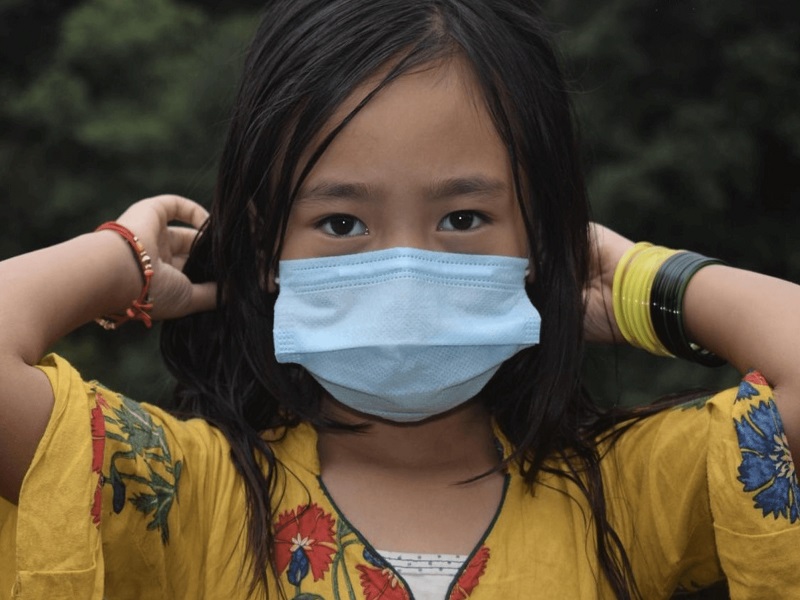While 'long-Covid' has come to mean lingering symptoms among survivors of Covid-19 infections, in Nepal it connotes the long-term socio-economic impact of the pandemic on children.
Even as the Omicron third wave spreads across Nepal, the government is struggling to vaccinate children down to age 12 and protect this vulnerable and unvaccinated age group from the virus. No vaccination has been announced yet for those below 12.
Side by side with that threat, more than one in five Nepali households continue to struggle for food due to lack of money and disruptions in supply caused by the Covid-19 pandemic, according to the latest findings of a nationwide survey.
The survey showed that in November, 21% of households struggled to obtain enough food, and nearly 10% of them had to reduce the dietary intake of children. However, while 60% of households surveyed in July 2020 said they had lost jobs, this number had declined substantially to 33% by November last year.
Still, this means one-third of Nepali families are at risk of poverty, and this undermines Nepal's steady success in reducing the rate of absolute poverty over the past two decades.The tracking survey has been conducted periodically by Sharecast Initiative Nepal with support from UNICEF Nepal since May 2020 to monitor household income, health and education during the pandemic. The Child and Family Tracker has so far conducted 8 nationwide surveys to monitor and gauge changes in the livelihoods of more than 7,000 households. It tracks their access to jobs, water, sanitation and hygiene (WASH) and children's access to education, including food intake and health, breastfeeding and pregnant mothers. Nepali Times has partnered with Sharecast Initiative in analysing some of this data over the past two years.
The latest survey shows that nearly one in three families are in need of financial assistance, and many families continue to be indebted. Disaggregated data shows that Dalit families are still more likely to incur debt, require food and financial support as an immediate need.The number of families reporting loss of jobs worsened in surveys conducted between May and July 2020 (climbing to as much as 60%) but has now come down to 19% in the latest survey conducted in November last year.A similar situation is seen for other parameters like food shortage and children out of school, with the impact of the lockdowns extending till late 2020, before improving in the past year. The most dramatic impact is seen in the proportion of children who were not studying at all, which came down from a high of 41% in May 2020 to only 3% in November 2021.
Similarly, families which have members with disabilities, as well as female-headed households have said they have been reaching out for financial support, food, and money. Children of such families predominate in most deprivation indicators.The results in education are a bit more uneven. While 60% of parents polled were confident about sending their children back to school, 80% felt that their children are falling behind in their studies. Only six in every ten households said their schools had handwashing facilities, and only a quarter confirmed their children's classrooms practiced physical distancing. As expected, the survey showed that children with disabilities were far more likely to face challenges with virtual learning, which has again returned to being the norm as schools stay closed after winter vacations due to the ongoing Omicron surge.Reports of domestic violence have gone up with 15% of households interviewed witnessing violence against women and children, including intimations, threats, insults and yelling. Girls are facing increasing pressure to marry early, and face discrimination in school enrolment.
One positive trend seems to be in the number of households that said they witnessed children working. Before the pandemic, a full 30% of families said child labour was present, this had gone down to 8% during the first lockdown in April 2020 and decreased further to 2% in the latest survey conducted in November 2021.
Another positive trend was a higher level of awareness about Covid-19 transmission and precautions. Most families appeared to be taking the necessary precautions with 84% reporting that they wore masks during the holiday season, and 71% of those surveyed had already been vaccinated as of November 2021.
The rate of hand-washing and use of sanitisers also remain high. Together masking, distancing and hygiene could also have an impact on reducing other common water- and air-borne infectious diseases in Nepal like diarrhoea, typhoid, tuberculosis, measles, etc.Unrelated to Covid, the survey also showed that among more than 7,000 households approached there appeared to be a high percentage of them with disabled members, with the highest proportion (21%) being in Karnali Province with Madhes Province and Bagmati at 16% each.Similarly, the survey also gives a glimpse of male out-migration with data showing one third of households in Gandaki Province being female-headed families. Madhes Province had the lowest proportion of women-led households (12%), with all other provinces showing about a quarter of families being female-headed.
nterestingly, the survey also showed that female-headed households had a disproportionately higher number of children living with them. Children made up 38% of the total members in households led by males, while in female-headed households children made up 43% of the members.
Source: Nepali Times
0 COMMENTS



